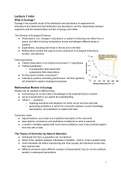Lecture 1 Intro
What is Ecology?
Ecology is the scientific study of the distribution and abundance of organisms the
interactions that determine that distribution and abundance, and the relationships between
organisms and the transformation and flux of energy and matter.
The Diversity of Ecological Evidence
● Observations, incl. changes in abundance or system functioning over either time or
space, and often involving comparisons across and between different areas or
systems
● Experiments, including both those in the lab and in the field
● Mathematical models that capture some component of ecological interactions,
function, and structure
Field experiments
● Careful observation in the natural environment => hypotheses
● Testing hypotheses:
○ A manipulative field experiment
○ comparative field observations
● Do they lead to similar conclusions?
● Laboratory systems (including greenhouses, common gardens)
are essential to capture ecological processes:
Mathematical Models in Ecology
Models can be valuable in different ways
● summarizing our current state of knowledge to the essential factors involved
● Act as a benchmark in our search for understanding
● “What if ...” questions:
○ exploring scenarios and situations for which we do not have real data
○ generating predictions in which the connection between current knowledge,
assumptions, and predictions is explicit and clear
Cautionary notes:
● Approximations: any model is an imperfect description of the real world
● Assumptions: conclusions and predictions conditional on what is assumed
● a model is inevitably applied with much more confidence once it has received support
from real sets of data
The Theory of Evolution by Natural Selection
● Individuals that form a population are not identical
● Some of the variation between individuals is heritable —that is, it has a genetic basis
● most individuals die before reproducing and most (usually all) reproduce at less than
their maximal rate
● Different ancestors leave different numbers of descendants; they do not all contribute
equally to subsequent generations
1
, ● Evolution is the change, over time, in the heritable characteristics of a population
● “the survival of the fittest” Those best able to survive the risks and hazards of the
environments; and those who were most capable of successful reproduction
● fitness the success of individuals in the process of natural selection
● Natural selection has no aim
● Evolution is particularly rapid and intense when two species interact: Coevolution
Species = organisms as being members of a single species if they could, at least potentially,
breed together in nature to produce fertile offspring
Ecological Speciation
1. Allopatric phase: subpopulations become
geographically isolated and natural selection drives
genetic adaptation to their local environments
2. a degree of reproductive isolation builds up between
the two
3. Sympatric phase: the two subpopulations remeet,
and natural selection will then favor any feature in
either subpopulation that reinforces reproductive
isolation
Sympatric speciation
2
,Lecture 2 Conditions and resources
Environmental Conditions
● Conditions are physicochemical features of the environment such as its temperature,
humidity, pH, or, in aquatic environments, salinity
○ An organism often alters the conditions in its immediate environment,
sometimes on a very large scale and sometimes only on a microscopic scale
○ But conditions are not consumed nor used up by the activities of organisms
● Environmental resources, by contrast, are consumed by organisms in the course of
their growth and reproduction
Response of Organisms to Temperature
● rates of growth and development - linearly related to the organism’s temperature
Conditions as Stimuli
● Many conditions are important stimuli for growth and development and prepare an
organism for conditions that are to come
● The most widely used external signal is the length of the period of daylight within the
daily cycle—the photoperiod
● On the approach of winter—as the photoperiod shortens—bears, cats, and many
other mammals develop a thickened fur coat, and very many insects enter a dormant
phase in which development is suspended and metabolic activity massively reduced,
called diapause
● Temperate-zone insects slow down their development as day length decreases in the
fall
● But they speed up development again in the spring as day length increases, once the
pressure is on to have reached the adult stage by the start of the breeding season
Responses to Environmental
Temperature
● Like plants, algae, bacteria, andarchaea, most species of animals are
ectotherms—they rely on external sources of heat to determine the pace of their
metabolism
○ The invertebrates, amphibians, reptiles, and most fish
● Others, mainly birds and mammals, are endotherms, they regulate their body
temperature by producing heat within their body
3
, Resources for Photosynthetic Organisms
● Resources may be either biotic or abiotic components of the environment—they are
whatever an organism use or consumes in its growth and maintenance, leaving less
available for other organisms
● Plants are an obvious example, depending upon:
○ Energy that radiates to them
○ Atmospheric carbon dioxide that diffuses to
them
○ Mineral cations that they obtain from soil
colloids in exchange for hydrogen ions
○ Water and dissolved anions that the roots
absorb from the soil
● Higher rate of photosynthesis with higher intensity of
the radiation
● this relationship itself varies greatly between species
● At high intensities, photoinhibition of photosynthesis may occur
Water Sun and shade plants
● Avoiders such as desert annuals, annual weeds,
and most crop plants have a short
lifespan—their photosynthetic activity is
concentrated during periods when water is
relatively available
● Other plants, tolerators, have evolved a different
compromise, producing long-lived leaves that
transpire slowly (for example, by having few and
sunken stomata)
Photosynthetic pathways: Increasing the Efficiency of Water Use
● The majority of plants on Earth: the C3 pathway
● Plants with the C4 pathway are far more
efficient in their use of carbon dioxide, and
therefore in their use of water as well
● CAM (crassulacean acid metabolism) plants
open their stomata at night and absorb carbon
dioxide
4




